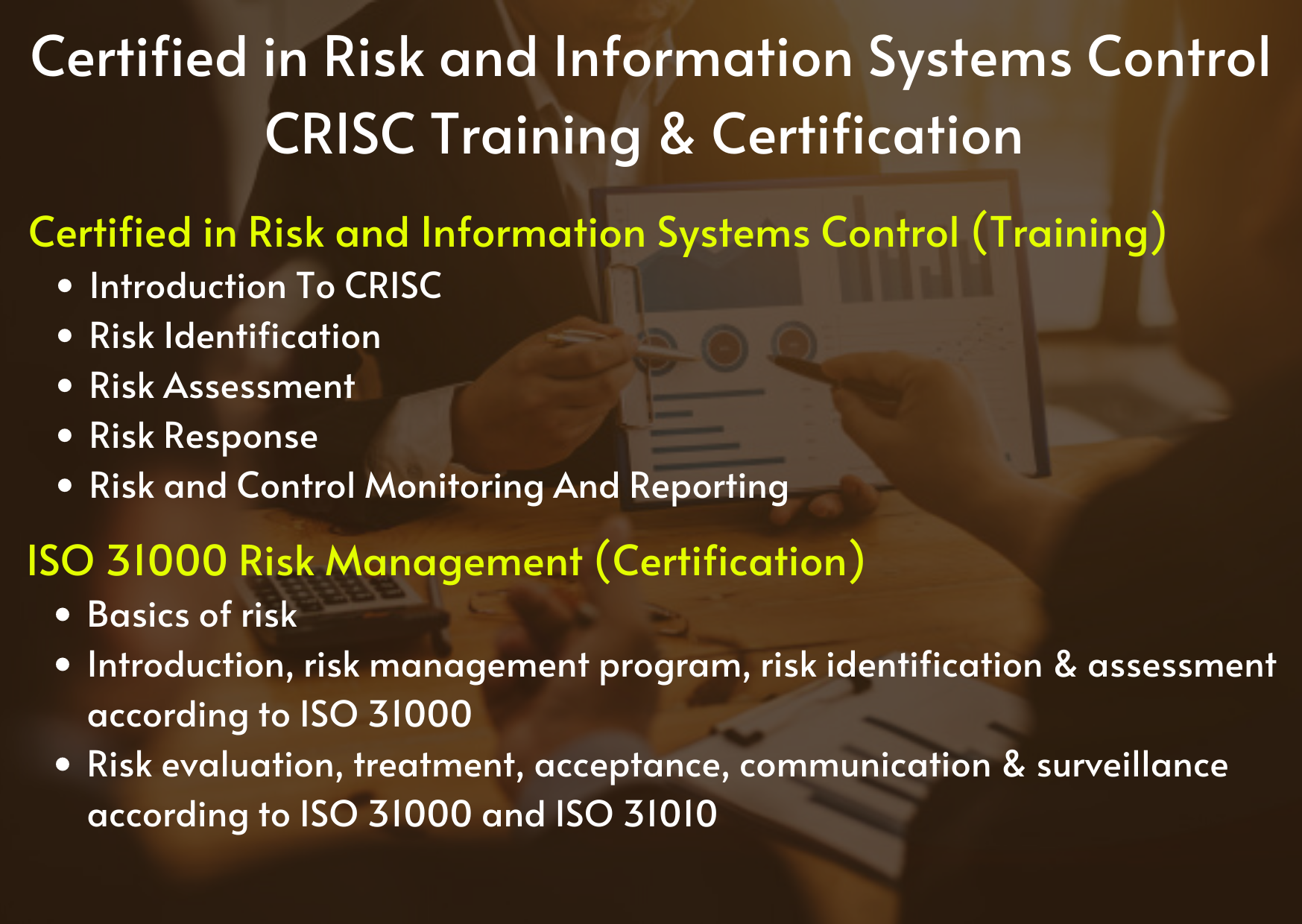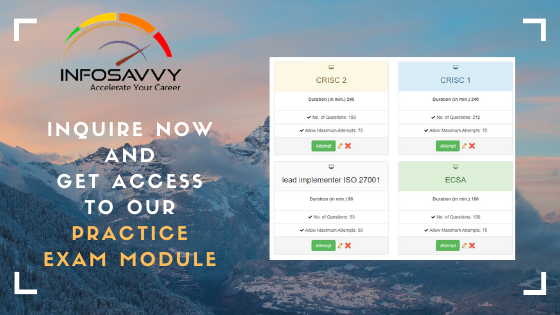CRISC training cost
CRISC by ISACA is a certification course offered by Info-savvy that recognizes the knowledge and training in the field of Risk Management for IT sectors. This course can help IT security professionals with a visible marketer of experience and knowledge for enterprise and financial sectors.

Who Should Attend
- IT professionals
- Project managers
- Risk professionals
- Control professionals
- Compliance professionals
- Business analysts
- Any candidate can attend training who want to learn about CISM
- Internal and external auditors
- IT and Information security professionals
- IS/IT Auditors
- IT Managers
- IS/IT Consultants
- IS/IT Audit Managers
- Security Professionals
- System Analysts
- CIOs
- CTOs
- Compliance officers
- Aspirants in the field of information security and assurance
Course Details
- Mode :- Live Online Training
- Actual fees- Rs. 25,000/-
Discounted fees- Rs. 17,000/- - Duration: 3 Days (Weekend Batch)
Get more Details- Certified in Risk and Information Systems Control | CRISC
Our Blog
Scenaro : 1. Victim opens the attacker’s web site. 2. Attacker sets up a web site which contain interesting and attractive content like ‘Do you want to make $1000 in a day? 3. Victim clicks to the interesting and attractive content URL. 4. Attacker creates a transparent ‘iframe’ in front of the URL which the victim attempts to click, so the victim thinks that he/she clicks on the ‘Do you want to make $1000 in
Sam is working as a system administrator in an organization . He captured the principle characteristics of a vulnerability and produced a numerical score to reflect its severity using CVSS v3.0 to properly assess and prioritize the organization’s vulnerability management processes. The base score that Sam obtained after performing CVSS rating was 4.0 What is CVSS severity level of the vulnerability discovered by Sam in the above scenario? Option 1 : Critical Option 2 :
Clark , a professional hacker, was hired by an organization to gather sensitive information about its competitors surreptitiously. Clark gathers the server IP address of the target organization using Whois footprinting. Further, he entered the server IP address as an input to an online tool to retrive information such as the network range of the target organization and to identify the network topology and operating system used in the network. What is the online tool
John a disgruntled ex-employee of an organization, contacted a professional hacker to exploit the organization. In the attack process, the professional hacker installed a scanner on a machine belonging to one of the victim and scanned several machines on the same network to identify vulnerabilities to perform further exploitation. What is the type of vulnerability assessment tool employed by john in the above scenario? Option 1 : Network-based scanner Option 2 : Agent-based scanner Option
An organization has automated the operation of critical infrastructure from a remote location. For this purpose, all the industrial control systems are connected to the INTERNET. To empower the manufacturing processs, ensure the reliability of industrial networks, and reduce downtime and service disruption, the organization decided to install an OT security tool that further protects against security incidents such as cyber espionage, zero-day attack, and malware. Which of the following tools must the organization employ
Ralph, a professional hacker, targeted Jane , who had recently bought new systems for her company. After a few days, Ralph contacted Jane while masquerading as a legitimate customer support executive, informing that her systems need to be serviced for proper functioning and that customer support will send a computer technician. Jane promptly replied positively. Ralph entered Jane’s company using this opportunity and gathered sensitive informations by scanning terminals for passwords, searching for important documents
Jason, an attacker, targeted an organization to perform an attack on its Internet-facing web server with the intention of gaining access to backend servers, which are protected by a firewall. In this process, he used a URL https://xyz.com/feed.php?url=externalsite.com/feed/to to obtain a remote feed and altered the URL input to the local host to view all the local resources on the target server. What is the type of attack Jason performed in the above scenario? Option
Security administrator John Smith has noticed abnormal amounts of traffic coming from local computers at night. Upon reviewing, he finds that user data have been exfiltered by an attacker. AV tools are unable to find any malicious software, and the IDS/IPS has not reported on any non – whitelisting programs. What type of malware did the attacker use to bypass the company ‘s application whitelisting? Option 1 : Phishing malware Option 2 : File-less malware
Gillbert, a web developer, uses a centralized web API to reduce complexity and increase the integrity of updating and changing data. For this purpose, he uses a web service that uses HTTP methods such as PUT, POST, GET, and DELETE and can improve the overall performance, visibility, scalability, reliability, and portability of an application. What is the type of web-service API mentioned in the above scenario? Option 1 : SOAP API Option 2 : RESET
Attacker lauren has gained the credentials of an organization’s internal server system, and she was often logging in during irregular times to monitor the network activities. The organization was skeptical about the login times and appointed security professional Robert to determine the issue. Robert analyzed the compromised device to find incident details such as the type of attack, its severity, target, impact, method of propagation, and vulnerabilities exploited. What is the incident handling and response
Showing the single result
-
IT Security & Governance
Certified in Risk and Information Systems Control | CRISC
Original price was: ₹25,000.00.₹20,000.00Current price is: ₹20,000.00. Add to cartCRISC by ISACA is a certification course offered by Infosavvy that recognizes the knowledge and training in the field of Risk Management for IT sectors. This course can help IT security professionals with a visible marketer of experience and knowledge for enterprise and financial sectors.
There are 4 domains which further divides the areas of risk management:
- Identifying risks.
- Assessing risks.
- Responding to and mitigating risks.
- Controlling, monitoring and reporting about risks.
Within these domains, CRISC measures an individual’s ability to deal with risks in an enterprise business and to use information system controls.
[ninja_form id=7]















